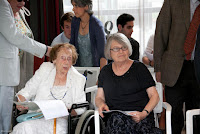We reel from daily news about unemployment and absurdly ignorant and embarrassing comments by Republican presidential candidates, and forget that truly important things are happening in the world around us.
The first week of August Anneke and I spent in the Hague, Amsterdam and Hilversum in the Netherlands revisiting her past and celebrating the people who made her survival possible during the Holocaust. At an event in the Hague, the Ambassador of Israeli to the Netherlands Henry Kney Tal honored Cora Greenaway de Jong and posthumously, Johannis Blacquiére and Jacoba Henriëtta Tissot van Patot, the Dutch Christian couple who kept her in hiding from the Nazis during the war, by presenting them with Yad Vashem medals of Righteous Among Nations reserved for non-Jews who saved Jewish people during the Holocaust. There names will appear on the wall in Jerusalem honoring those who saved Jews during the War.
Cora and Jan and Co Blacquiére risked their own lives and those of other family members to save one small Jewish girl from the certain death, along with her mother Leni and father Erich Kohnke suffered in Auschwitz. Cora was a 26 year old art student who was a courier for the Dutch Resistance, who retrieved 18-month old Anneke from her parents apartment in Amsterdam, and took her on a series of harrowing tram and train rides under the noses of the Nazi SS and the Dutch NSB fascist collaborators, to Voorburg, a small village outside of the Hague where she left her on a dark train platform with a man whose name she did not know, nor whose face she would ever see. She trusted that the man would care for her precious baby, who she only knew as “the baby”. For over three years, the Blacquiére family included little Anneke among their own children as though she was one of their own, receiving nothing other than a child’s love for their efforts. Together they survived the famine of the Hongerwinter. After the War she lived with Otto Frank for a time before obtaining a Visa to the US where she arrived July 16, 1946. Anneke's mother Leni and Edith Hollander Frank had been good friends before the War and Anne Frank had baby sat for Anneke when she was an infant.
 |
| Anneke (right), Fred (middle) and Ron Blacquiére 1944 |
Cora searched for ‘her baby” until four years ago when, via the internet with friend Niek Versteeg's help, she tracked Anneke down and contacted her. Before she died, Co Blaquiére made her son Fred promise he would find Anneke and tell her about his life with them, which he did, after many years of searching. Today Cora is 96 years old and Co and Jan Blacquiére’s son Fred, Anneke’s childhood playmate and brother is 69 years old, and received their long-overdue recognition.
 |
| Cora and Anneke at the Yad Vashem Ceremony in The Hague Aug 4, 2011 |
 |
| Fred Blacquiére, son of Co and Jan Blacquiér,e receiving Yad Vashem medal posthumously from Isreali Ambassador on behalf of his parents |
During our trip we visited the house where Anneke was born in Hilversum, the apartment in Amsterdam from which Cora took her to the safety of the Blacquiéres, and the home where she lived with them from 1942-45 along the Vliet canal in Voorburg, not all that different to day from what they were 66 years ago.
Two Dutch film-makers, Deborah van Dam and Martine van Poeteren who are making a documentary film about Anneke, Cora and the Blacquiére's, story recently spent a week with us in Minnesota, and then accompanied us on the plane to Amsterdam to document the reunion. Their project will be complete by sometime Spring 2012.
It is reassuring that sometimes we recognize that some things are truly important while others are hardly worth spending time thinking about.

Thank you for sharing your wife's amazing story.
ReplyDeleteThat's so powerful that I'm wiping away the tears. Please give my warm Uncle Dickie humanistic hug to Anneke
ReplyDeleteI saw the finished documentary on Sweden's state TV-channel "Kunskapskanalen" (The knowledge channel) today and was very moved. At the end, all people involved are forced to reevalute their perceptions about history and memory.
ReplyDeleteAnd how did it really happen when Anneke's father was caught out on the street? Did he really give away their hiding place?
The discriptions of Anneke after being taken out of the foster home are horrific, and can still teach us something about children's needs and development. Please make sure a lot of people see this documentary!
Just wanted to share my reflections.
//
Christine, 29
Sweden